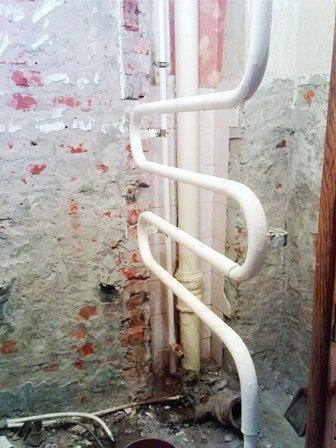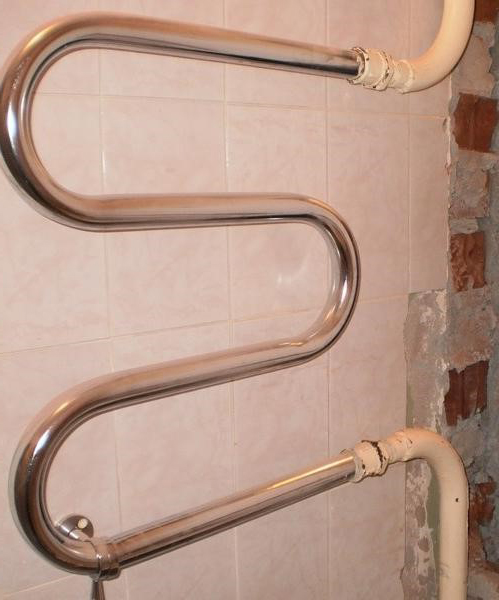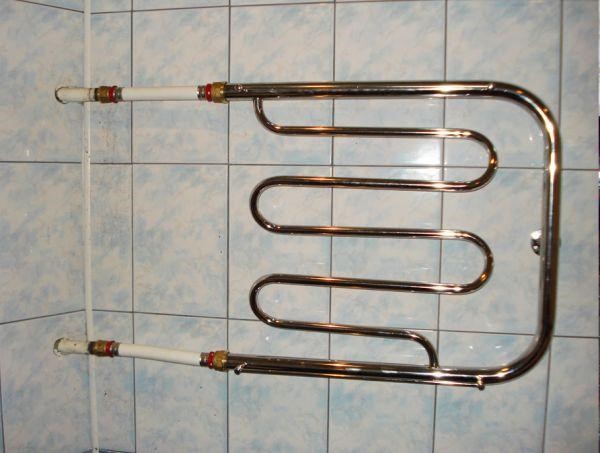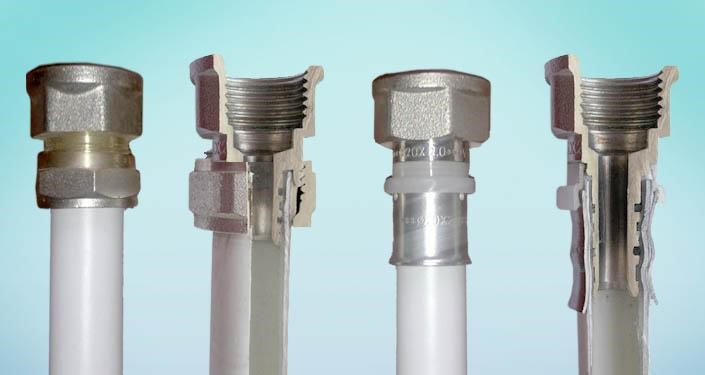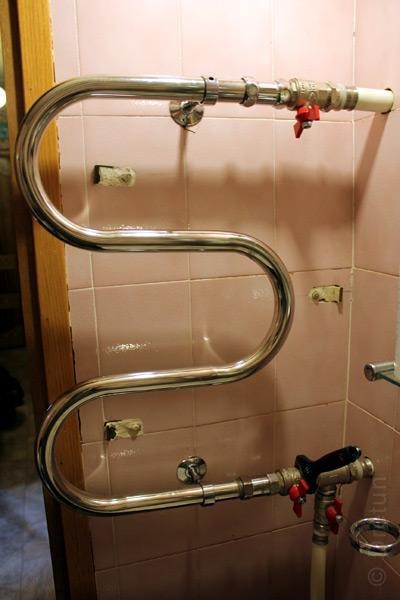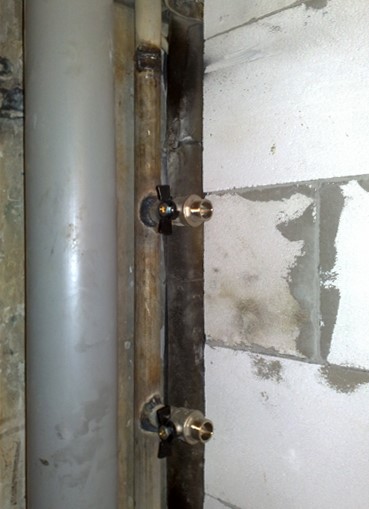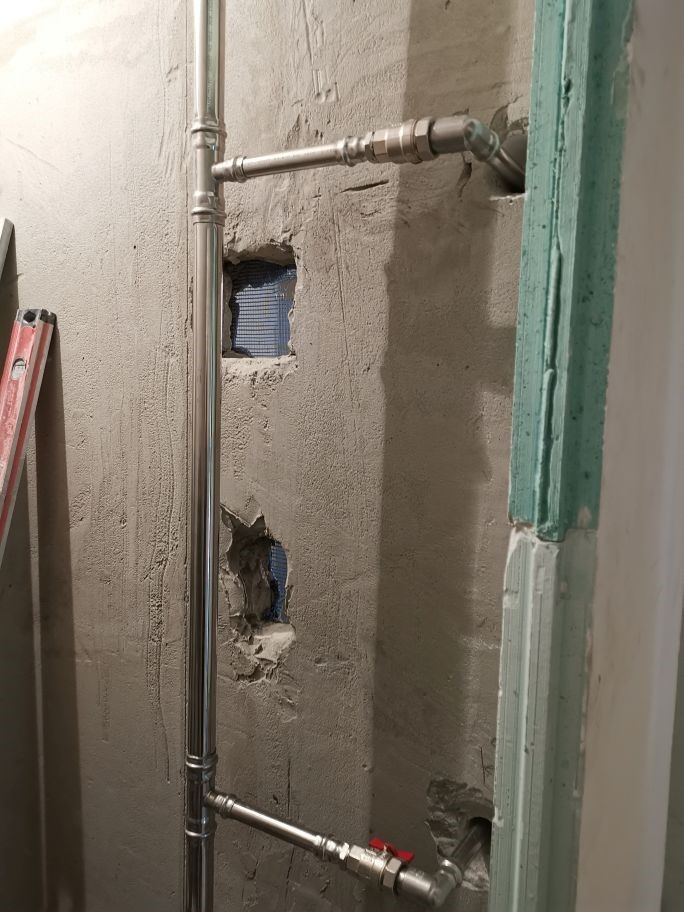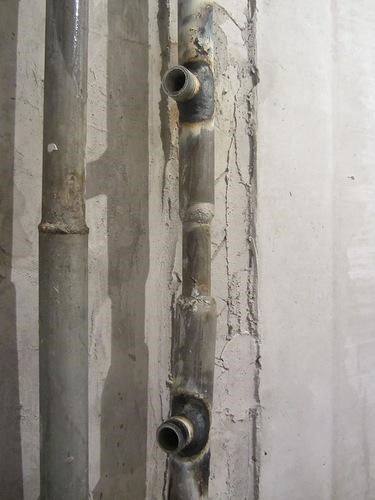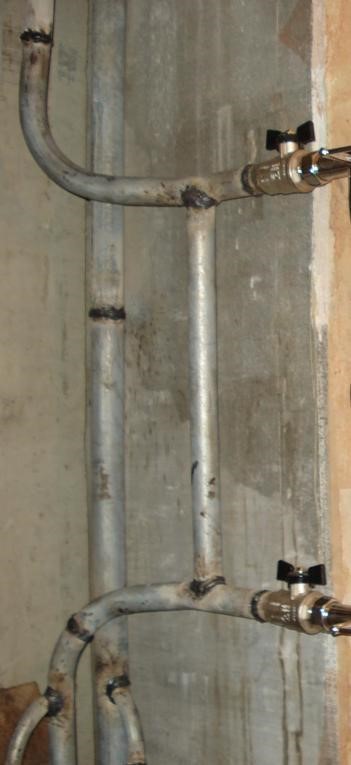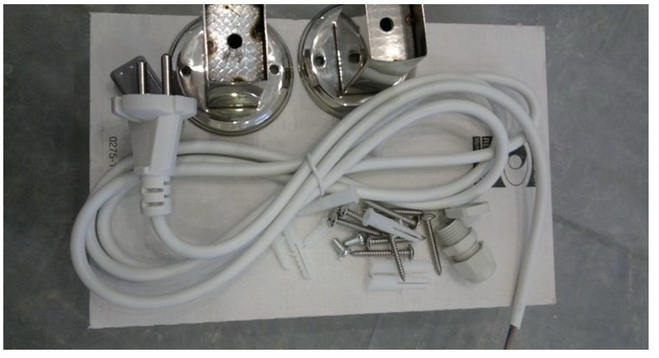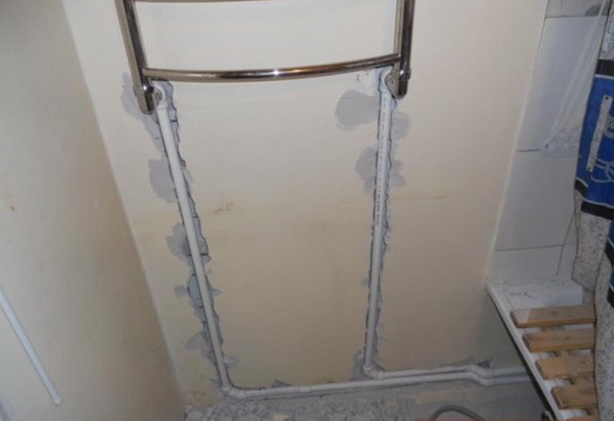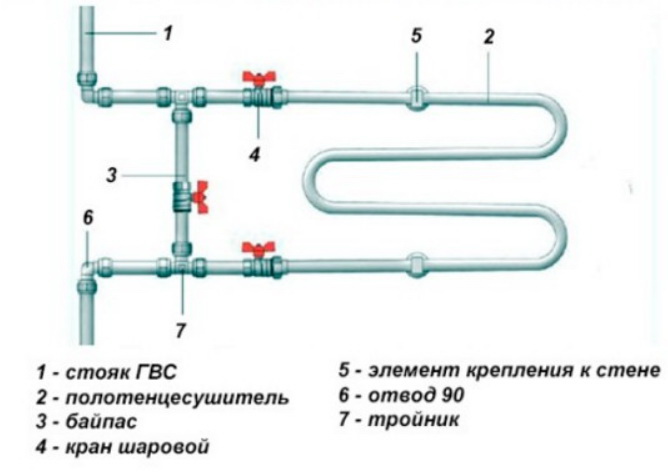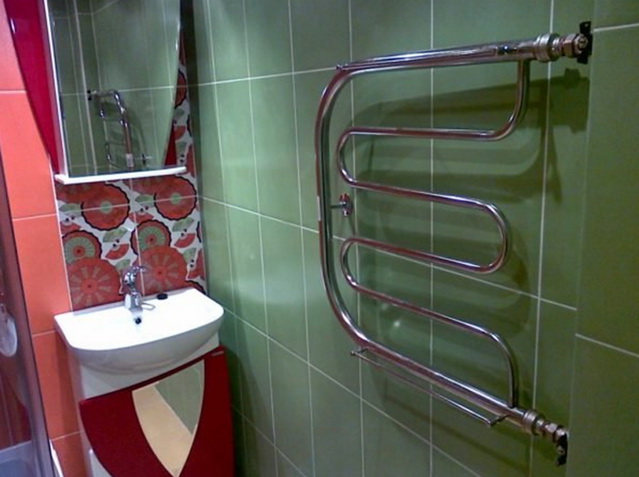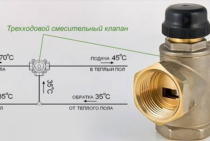Expert answers
Alexander Zakharenkov:
valve 2 should not be, valve 3 should be on the return line, and there are no check valves. Towel dryer - heating device! In this case, it takes heat from the hot water supply that enters your apartment, and you are billed as normal. The system requires constant adjustment, because any manipulations with the heated towel rail change the parameters of the branches. The solution is as follows - first of all, be sure to place all builders / installers / designers / plumbers in the fireplace / stove, burn them all completely so that nothing is left of them, dispose of the ashes. Secondly, lay a DHW return riser for heated towel rails, remove valve 2. And you also need to independently check whether the valves on the return line are open. While the house is new, everything can be done
Anatoly Bondar:
Of course, as always, carrots are sweeter with neighbors (more pressure)))). The pressure is the same, but the air pockets in your heated towel rails have probably accumulated. It doesn't take one day to get out. The hot water flow is interrupted, there is no normal circulation. Taps No. 2 must all be open.
re:
do not put a valve on the riser. in the basement it is necessary to open the valves on the supply and return and let the air out at the top point. it is the responsibility of the UK to restore circulation you pay them for maintenance and repairs
Elektriker (DIXI!I):
they didn’t open the return line, probably the valve is crappy there in the basement
drinker in the thorn bush:
Why did they put a crane on the riser? .. This is a violation, you are not the only one hanging on it ..)
Alexei:
An awesome system, especially valve number 2. In addition, it was probably made with ball valves, and not with valves. Whoever had a thread had a Turkish tap and blocked the riser by a third - the entire entrance was looking for heat and hot water. And he's not at home
Mikhail Podvolotsky:
Valve #2 is redundant. It's blocked or broken. Creates resistance on the DHW riser. You most likely have several DHW risers for the whole house. Well, all the risers are simultaneously adjusted by the developer so that the pressure loss in the risers does not differ by + -10%. When you installed the valve, you changed the hydraulics in your riser (increased). The circulation now does not go through your riser, but goes through neighboring risers better, but worse through yours. now reconfigure in the basement with pressure regulators or washers, I don’t know what is there ..
Ivan Gorshnev:
If it is blocked, then there will be no circulation of hot water. Usually, the coil is placed on the return line of hot water. According to this scheme, in your case, the neighbors will have hot water, but it will cool down and every time you turn on the hot water, you will have to drain the water until the freshly hot water reaches the tap and the coils at the entire riser will be cold, but there is no difference to close one tap or both
目的是什么利益?:
the water won't come out. you don’t have the right to block - the neighbors will stop working
Yurets:
add 2 valves to it and forward flow bypassing the pipe, like batteries with temperature control
Galina Nikitina:
Do not turn it off: it will be damp in the bath, mold will go on the walls.
Andrey Rykov:
if you just close it, then the neighbors from above will run out of water. it is necessary to make a detour, and already let water through it
Grandfather Au:
Post a pic and let's say. Maybe not at all
Vladimir Vladimirovich:
ask the plumber that you laid the pipes. Everything is individual here, but in general, turn everything off, so you can’t go wrong
Vladimir Petrov:
If you do not have a bypass for a heated towel rail, then you cannot block it, otherwise you will simply deprive all other apartments of hot water. And so it doesn't matter, just close one tap, you can two and that's it. And you can’t drain the water from it, otherwise it will rust
Nata Clay:
Remove your heated towel rail and install an electric one. The problem will be solved once and for all. This can be turned on only when necessary and adjust the heating temperature. But this is not the case for all models. There is an obvious advantage, you can install it anywhere where water does not get in, of course.Format, configuration, materials, color - also to choose from. Our neighbors installed such a battery, the water one constantly leaked on our heads.
Egor Mikhailov:
And when I was doing repairs, I installed an electric heated towel rail. Now there are no problems, when I want, then I turn it on. From the old heated towel rail in the bathroom there was stuffiness in the summer when the hot water was turned on.
Best Answers
*FOX*not*SISTER*:
If you have it from hot water, it should always be hot, but in some houses for some reason the heated towel rail is from the heating system, then it will be cold when the heating is turned off.
Maria:
Yes. It always stays hot.
How I Want So I Live:
We are always warm, hot in winter, but I don’t know how to do it
Elena:
no, of course, it's the same battery - only in the bathroom)
Yuri Frolov:
Yes, it is heated not from heating, but from hot water. That's how it is in our house, anyway.
Alexey Kulikov:
Towel dryers, as a rule, are connected to the hot water supply riser. Very rarely - to heating.
Marina Sakharova:
See what's heating it up. If from hot water, then it should (if it comes from the tap hot). If from heating or from electricity, then it should not.
Arkady:
Maybe he's on hot tap water.
Fabull:
It's actually a hot water return, you can check it on the top floor.
Chufistova Maria:
must, when we don’t have hot water, the dryer is cold, otherwise it’s always hot
Lollipop:
hot, correctly answered, depends on hot water, not heating.
Helena Iskra:
The heated towel rail is powered by hot water, not heating
Sergey Ivanov:
If it is powered by hot water, then yes, but if it is from heating (as a rule), then no.
Igor Shkurny:
In 90%, the towel hangs on the hot water supply and is not connected with heating!!!
ludwig:
now read that I am writing a towel from water (hot riser) if there is circulation, it is always hot, but if it is from heating, then it is hot only when it is flooded
Scrapmaster Honored:
We have a separate riser from the central heating. It does not heat up when there is no pressure in the radiators. If you connect to hot water, you need to dump chilled water somewhere so that the towel is hot. Most often this is done by residents of the upper floors ...
Albert Belkov:
Yes, in a cooperative nine-story brick building with its own boiler room - so ...
Old Plinth:
Maybe an electric towel?
Vladimir Sokolov:
should always be hot! looping goes regardless of heating! My parents had a cold in the morning, so from my submission (I am a welder-plumber of 12l of experience) they got a REO, they did it, although at first they refused, like it should be! have been looking for a long time (well, like) replaced the return faucet, now the only 1 riser in the house is hot!
Natalia Victorovna:
and took the temperature... yourself... maybe heat, glitches, it seemed .... ARVI walks now, maybe he got sick
first figure out why your towel is powered
A bit of history old types of heated towel rails
Twenty years ago, a heated towel rail "from the developer" was a monolithic riser pipe, curved in the form of the letters P or M. The heated towel rail acted as a compensation loop and leveled linear thermal expansions on the riser.

U- and M-shaped heated towel rail as part of the riser
New towel warmer that is part of the riser (correct)
Despite the unsightly appearance, this type had undeniable advantages: it was constantly hot, did not introduce any noticeable hydraulic resistance, and did not allow residents to disrupt the operation of the hot water riser.
However, as time went on, and the tenants in the old housing stock, changed the old and ugly heated towel rail to a new and shiny one.
The installation was successful if the diameter of the heated towel rail corresponded to the diameter of the riser, and the connection was made without narrowing and shutoff valves (faucets).
In case of an unsuccessful scenario, the result was the following:
New towel warmer that is part of the riser (incorrect)
Attentive readers will notice that four extra narrowings from the applied fittings appeared in the riser.
Internal section of a fitting for metal-polymer pipes
But this is not the worst case either. Sometimes it happens:
A new heated towel rail that is part of the riser (strictly prohibited)
In addition to the narrowing already mentioned above, shut-off valves have been added. When any of them is blocked in the riser, the circulation stops completely, the pressure in the apartments following in the direction of supply drops, the riser cools quickly if there is no water intake, and cold water has to be drained for a long time when the mixers are opened. Not the most pleasant picture, which also promises a showdown with neighbors!
It is important to remember: the installation of shut-off and control valves on risers is strictly prohibited!
Taps from the riser and bypass for heated towel rails
Over time, developers began to use more modern technologies and, instead of a compensation loop, they began to make two outlets from the riser to connect a heated towel rail at the choice of the residents themselves.
In this case, there is always a bypass between the taps - the closing section of the pipe with a diameter equal to the diameter of the riser or one step less.
The bypass at the heated towel rail solves several problems:
- 1. Maintaining normal circulation speed throughout the hot water riser. Forced circulation in the riser ensures the supply of evenly hot water (according to the norms - at least 60 ° C) to any apartment, on any floor, regardless of its distance from the start of supply to the riser, the time of day and the presence or absence of water intake in the residents' apartments.
- 2. Only a part of the total heat carrier (water) flow passes through one heated towel rail. The other part goes by, keeping more heat for the next bathrooms, because one or two dozen heated towel rails can work from one riser.
- 3. It is possible to completely turn off the heated towel rail or adjust its temperature by residents without negative consequences for other apartments. The ability to adjust the temperature requires the installation of an additional control valve on one of the outlets, since it is impossible to regulate anything using a ball valve.
But even here there is a problem: the height of the taps from the floor, the distance between them, the diameter and type of bypass are not standardized in any way. This leads to massive problems when connecting heated towel rails, which will be discussed below.
Three basic versions of bypass with taps:
1. Unbiased and unconstricted bypass. The outlets are welded directly to the riser pipe. Between the branches, the geometry of the riser (this is the diameter of the pipe and its direction) remains unchanged. You can often hear “oh, but I don’t have a bypass!” - but in fact, here the bypass is just part of the riser.
Non-offset and non-constricted bypass (galvanized riser)
Unshifted and unconstricted bypass (stainless steel riser)
2. Unbiased narrowed bypass. Between the bends, the diameter of the riser is reduced by one pipe size (for example, for a 1” riser, a 3/4” bypass is performed), the riser itself still remains straight. Perhaps the most common option, which, alas, brings a lot of problems under certain conditions.
Non-offset narrowed bypass (galvanized riser)
3. Offset narrow or open bypass. Between the taps, the section of the riser is shifted towards the heated towel rail, and the displaced section can be additionally narrowed by one diameter step. Also problematic in many cases.
Offset open bypass (galvanized riser)
And here are the approximate coefficients for the flow of water into the heated towel rail for different bypass configurations. Remember that they are valid only when choosing a uniquely working connection scheme from the options presented below.
- Offset bypass: 0.33-0.4.
- Offset and at the same time narrowed by one diameter step bypass: 0.48-0.52.
- Unbiased narrow bypass: 0.4.
That is, the bypass offset in terms of efficiency is almost equivalent to its narrowing.
Scheme 3
(Side and diagonal connections with reduced and/or offset bypass)
The vast majority of plumbers believe that there must be a narrowing between the taps on the heated towel rail - otherwise nothing will work. Firstly, this is not the case (see the diagrams above), and secondly, in the case of a lower water supply in the riser, the narrowing will prevent the heated towel rail from working.

Lateral connection of a ladder, working on a combination of forced and natural circulation, with a narrowing of the bypass

Lateral connection of a ladder, working on a combination of forced and natural circulation, with a bypass offset

Side connection of the U / M-shaped heated towel rail, working on a combination of forced and natural circulation, with bypass offset

Lateral connection of the U/M-shaped heated towel rail, operating on a combination of forced and natural circulation, with narrowing of the bypass

Diagonal connection of the ladder, working on a combination of forced and natural circulation, with a narrowing of the bypass

Diagonal ladder connection, working on a combination of forced and natural circulation, with bypass offset
Diagonal options for connecting a heated towel rail do not have any advantages over the side ones.
Note that the direction of supply in the riser is now unambiguously indicated by the top. With the bottom feed, these options are categorically not recommended to use! Benefits of the scheme:
Benefits of the scheme:
- Works great with top feed in the riser.
- It is not required to bleed air from the device after turning off the water.
- The distance of the towel warmer from the riser is up to 8-10 meters.
The disadvantages of the scheme:
Stable operation is guaranteed for top feed only.
Conditions for the scheme to work:
- Strictly top feed in the riser! In general, you should consider the direction of supply always unknown (despite the statements of local plumbers) and use any of the universal schemes that do not depend on the supply.
- The lower outlet of the riser must be below or on a par with the bottom of the appliance, and the upper outlet of the riser must be above or on a par with the top of the heated towel rail.
Connecting an electric towel warmer
The electrical version of the device is connected most simply. Sometimes it is literally enough to insert the plug into the socket. But only if there is a high-quality protected socket, and the design of the device, and its low power, imply such a connection, which is necessarily specified in the instructions.
If the instruction attached to the device prescribes the connection of an electric heated towel rail with a separate solid cable to the protective relay on the shield, with the installation of an enabling device, then this must be done. It is understood here that the device is a permanently operating, increased power.
Unreliable contacts in the circuit are not allowed - over time they will heat up, ignite. The cable is used of the appropriate quality and cross-section of cores, laid in accordance with the rules.
How to install and secure
The heated towel rail is installed at a certain distance from the wall, such that it is convenient to hang towels on it. The device is hung on the wall on brackets, which are usually supplied.

Models designed for hidden piping are not rare. With a fixed exact distance of the leads coming out of the wall.
Then the instrument kit necessarily contains hydraulic eccentrics, with the help of which geometric inaccuracies are leveled. Another threaded fitting connection is added.

Variants of a “simple snake” are possible when universal brackets are needed - from radiators, while at least 4 of them are installed. - under the upper bend of the pipe and under the lower one, so that the structure is reliable and does not stagger if the supply pipes are soft.
In the case of installation on a steel connection, one safety crimp is usually installed on the opposite side of the connection.
The height from the floor may vary, but as a rule, the heated towel rail is installed in the middle part of the wall, the height from the lower bend of the pipe to the floor is about 100 cm.
Installation sequence
The installation instructions are studied, all the prescribed actions are performed for the specific model of the heated towel rail.
Connection points are being prepared - pipes are brought in, shut-off valves are installed on them, then they are supplied (as a rule) with American women for quick installation/dismantling of the device. The distance between the inlets must correspond to the model of the device.
The position of the brackets, fixing points are marked, holes for dowels of the appropriate diameter are drilled using a perforator.
Corner adapters, eccentrics (if equipped), then Americans are screwed onto the outlets of the heated towel rail.
As an option for individual models, adapters are first screwed onto a smaller pipe diameter corresponding to the wiring, for example, 1/2 inch, which reduces the cost of the entire structure as a whole.
During installation, a seal is used - linen and special grease, threaded connections on metal fittings are tightened only on linen (plumbing thread) using keys.
The heated towel rail is hung on the brackets, the Americans (eccentrics) are connected. The system is filled with coolant.
